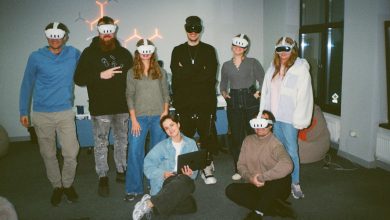
The BBC recently reported there will be no full-time return to the office for over a million, with many implementing a hybrid working framework. With this working style just in its infancy, companies today are just becoming familiar with how to implement it successfully. This article will look at what hybrid working is, who wants it and how technology and AI will play a role as companies move to this new era of working.
What is hybrid working?
The hybrid working model allows workplace teams to blend working onsite, directly from the office, with working from remote locations. A successful hybrid model is implemented effectively through positive culture and effective communication. The working style is largely reliant on technology as many workers can be remotely located at any given time. Hybrid work has many variations: some workers may want to work totally on-site, others completely remotely. Most commonly it is a blend of the two scenarios.
People want hybrid work, and companies are adapting
According to a survey by Microsoft, over 70% of teams want flexible remote work options to continue post pandemic, while over 65% are craving more in-person time with their teams. Companies are responding by redesigning office spaces and systems to better accommodate hybrid work environments. So, the results are in, and it’s clear, hybrid working is here to stay and will continue to be shaped as the pandemic restrictions continue to ease.
How can technology play a role in this?
Communication
When the pandemic first hit, cloud-based communication tools hit the roof. Zoom became a verb, and every company was more reliant on technology than ever before. As restrictions ease, communication platforms will continue to play a key role, but at Omnifia we’re seeing a growing problem with interruption-based communication channels. Studies have shown interruptions can happen 4-12 times an hour and it can take individuals as long as 20 minutes to refocus. The technology will continue to adapt with the changing environment and needs of businesses.
Knowledge discovery
As learning from osmosis will be reduced for many office-based workers post-pandemic, having the correct tools in place so teams can easily discover workplace knowledge will be key. When teams aren’t learning or developing and don’t have the necessary tools to do so intuitively, it can often lead to demotivation and unproductive teams. Knowledge discovery tools that centralise applications and cut out the noise will be crucial in ensuring teams keep developing and companies maintain and improve their levels of productivity.
How will AI play a role?
Companies can also implement AI technology to improve communication and knowledge discovery in the hybrid workplace. How could this work in practice?
AI-driven search
Companies create and manage (or don’t) more data than ever, with IDC saying this doubles every four years. Therein lies a real problem: finding that information needle in the digital haystack is truly painful. It is no wonder it can take some individuals 25% of their day to find information.
An omni-application workplace search, that continuously learns from individual preferences, responds to natural language and has a learning-enabled relevance result ranking will dramatically improve the accessibility of information. Just how Google operates at the beginning of a web user’s journey, teams should be able to begin their discovery with a workplace search.
Intuitive workplace updates
Alongside the ever-increasing amount of data, the SaaS industry is growing fast, at 30% a year. This means there are a multitude of fragmented platforms that have little integrations and each require separate logins. Often workplace teams don’t even know a piece of knowledge exists, or that their team has just collaborated and created a new fantastic guide or e-book until much later. If people don’t know it exists, why would they search for it?
A workplace feed that truly integrates one’s applications, beit a Hubspot, Trello, Google Workplace, Slack and so on, and places content updates in real time and automatically will enable hybrid teams to intuitively discover what’s important to them. Just as Facebook’s and Instagram’s feeds are personalized to each user’s preferences, a workplace feed does the same. For example, the algorithm will recognise the user is a marketer and will display HubSpot deal flow changes and branding guidelines amendments.
How to implement AI-driven knowledge discovery?
Unify knowledge sources
For organisations to get to the point where they can benefit from AI-driven knowledge discovery features, they firstly need to bring together all of the knowledge that’s currently stored in distributed data silos. Bringing data and knowledge together makes companies succeed as greater access to it means decisions can be made faster, and with greater clarity. It’s important this data point has regular and continuous information ingestions to ensure the data is up-to-date and reliable.
Democratise knowledge access
Once all the knowledge has been centralised into an API, interfaces can be built for teams and individuals within companies to easily access the knowledge. Features built on top of the data set, such as omni-application search, or a workplace feed can be fed through onto a user-friendly platform. On the developer side, engineers can use this 360 API to build unique applications for businesses.
Our take
As companies first faced the pandemic, they were forced into a new way of working that was facilitated by cloud-based technology platforms. As restrictions begin to ease and hybrid working becomes the new normal, companies will continue to be heavily reliant on digital platforms, and will continue to create a huge amount of data.
Those that make this data and knowledge easily accessible to enable fast and clear decision making will be the winners post-pandemic. Whether companies extract value from this data successfully will be dependent on how well they make use of new and cutting-edge technologies.
About Omnifia
Omnifia is an AI-powered productivity tool that allows companies to bring together all of their disconnected applications, enabling them to quickly discover workplace knowledge. Workplace knowledge is ingested every second, enabling teams to learn quickly through a cross-company search and personalised knowledge-dashboard. Companies can supercharge knowledge discovery and drive productivity through accelerated knowledge transfer.
LinkedIn: https://www.linkedin.com/company/omnifia/
Twitter: https://twitter.com/omnifia
Email: [email protected]




